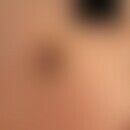Synonym(s)
HistoryThis section has been translated automatically.
Pearson K et al. 1911
DefinitionThis section has been translated automatically.
Albinism is the genetically determined absence of pigment. Clinically, it is a group of genetically different diseases characterized by a generalized or partial loss of pigment in the skin, hair and eyes (oculocutaneous albinism - OCA) or only in the eyes (ocular albinism) (note: only albinism type IA and generalized vitiligo show a complete loss of pigment). The underlying cause is a congenital, mostly autosomal recessive inherited disorder of melanin synthesis (defect in tyrosine kinase) with a normal intraepidermal melanocyte count. The combination of pigment disorders on the skin, hair and eyes is referred to as oculocutaneous albinism, the localized infestation of the eyes as ocular albinism.
You might also be interested in
ClassificationThis section has been translated automatically.
The following entities can be distinguished:
- Oculocutaneous albinism (OCA types 1-8)
- Ocular albinism (dermatologically irrelevant): 5 forms with varying degrees of iris depigmentation. Additionally photophobia, possibly nystagmus, strabismus, hypoplasia of the central fovea.
- Further, rare, syndromatic forms of albinimus (also known as "albinoidism") with generalized, pronounced hypopigmentation and additional organ manifestations that are decisive for morbidity and prognosis:
EtiopathogenesisThis section has been translated automatically.
There are now eight documented OCA types (OCA1-8) with non-syndromic features. Molecular studies have identified seven genes associated with the OCA phenotype:
- TYR gene
- OCA2 gene
- TYRP1 gene
- SLC45A2 gene
- C24A5 gene
- C10orf11 gene
- DCT gene
and a locus(OCA5) in consanguineous and sporadic albinism.
General therapyThis section has been translated automatically.
External therapyThis section has been translated automatically.
Internal therapyThis section has been translated automatically.
Note(s)This section has been translated automatically.
Albinism must be distinguished from piebaldism (known as leucism in veterinary medicine), in which melanocytes are completely absent in the depigmented areas due to gene mutations (mutations in the KIT (see kit below) and SLUG (SNAI2 - snail homolog 2 transcription factor) gene (Saleem MD et al. 2019) have been proven).
LiteratureThis section has been translated automatically.
- Böhm M (2015) Differential diagnosis of hypomelanosis. Dermatologist 66: 945-958
- Bohn G et al. (2007) A novel human primary immunodeficiency syndrome caused by deficiency of endosomal adaptor protein p14. Nature Med 13: 38-45.
- Pearson K et al. (1911) a monograph on albinism in men; Draper`s company reseach memoirs, Biometric series VI. Dula, London
- Saleem MD et al. (2019) Biology of human melanocyte development, Piebaldism, and Waardenburg syndrome. Pediatr Dermatol 36:72-84.
- Schiefermeier N et al. (2014) The late endosomal p14-MP1 (LAMTOR2/3) complex regulates focal adhesion dynamics during cell migration. J Cell Biol 205:525-540.
Incoming links (24)
Achromia; Albinism; Albinism oculocutaneous, brown; Albinism oculocutaneous tyrosinase-negative; Albinism oculocutaneous tyrosinase-positive; Albinism, oculocutaneous, yellow mutant; Albinism totalis; Albinism, universally complete; Albinoidism, oculocutaneous; Alphoderma; ... Show allOutgoing links (20)
Albinism oculocutaneous (overview); Albinism oculocutaneous type 5; Beta-carotene; Camouflage; Chediak higashi syndrome; Cross syndrome; DCT gene; Griscelli syndrome; Hermansky-pudlak syndrome; KIT gene; ... Show allDisclaimer
Please ask your physician for a reliable diagnosis. This website is only meant as a reference.




